|
FAQs about Zoanthid Predators, Pests
FAQs on Zoanthid Disease:
Zoanthid Health, Pests, Predator 1,
Zoanthid Health, Pests Predators 2,
Zoanthid Health, Pests, Predators 3,
Zoanthid Hlth., Pests, Pred.s 4,
Zoanthid Hlth., Pests, Pred.s 5,
Zoanthid Hlth., Pests, Pred.s
6, Zoanthid Hlth., Pests,
Pred.s 7,
FAQs on Zoanthid Disease by Category:
Diagnosis,
Environmental,
(Pollution/Poisoning,
Lighting...), Nutritional,
Social (Allelopathy),
Trauma,
Pathogenic (Infectious, Parasitic, Viral)
Treatments
& Zoanthid
Reproduction/Propagation,
Related Articles: Zoanthids, Sea Mat: An
Ocean Of Color For The Aquarium by Blane Perun,
Related FAQs: Zoanthids, Zoanthids 2, Zoanthids 3, Zoanthid ID, Zoanthid Behavior, Zoanthid Compatibility, Zoanthid Selection, Zoanthid System, Zoanthid Lighting, Zoanthid Feeding, Zoanthid
Reproduction,
|
Snails of various sorts, Nudibranchs, some
mites, crustaceans... Some folks even think Pycnogonids (Sea Spiders) are
problematical
Exclusion via quarantine of new specimens is best...
Next, biological controls...
Last: Chemical treatment
|
| |
Heliacus snail
Nudibranch
Amphipods |
|
| |
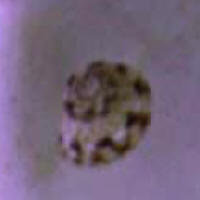 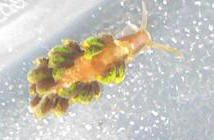 /Amphipods/evilpods99.jpg) |
|
|
What could this be? 8/4/16
Hi I found a few of these critters crawling on some Zoanthid frags. You can
not see these with the naked eye. I found them with a jewelers loupe and
then took these photos with my iPhone under a microscope. Hoping they are a
detritivore but I am fearing the worst. Thanks in advance.
Brian
<Appear to be Mites/Acarinans... I wouldn't panic. Bob Fenner>
|
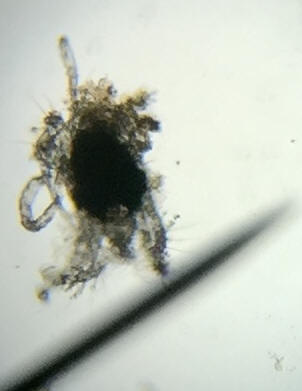
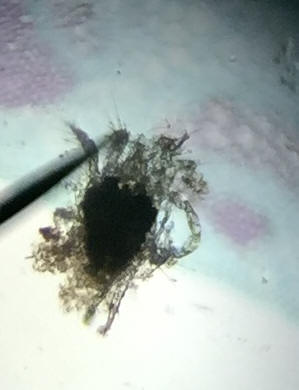 |
trying to id a hitchhiker on my Zoanthid coral
4/9/16
Hello Crew,
<Eric>
I'm trying to id a hitchhiker that came on my Zoanthid coral. it
looks like it has tentacles and is very fast.
<A polyp...?>
it seems to cover my polyps with a tough fibrous film overnight
<Interesting>
and also has built a den type cave with a very tough covering, some type
of fibrous material and lots of very tiny white sea shells mixed in as
well.
<Mmm; a Sedentariate Polychaete.... likely>
it's killing all my Zoanthids
<Unusual; what other life is here? Water quality measures? What changed
recently?>
and I haven't been able to see any more of it than 4 small tan looking
tentacles that come out and if it sees a shadow it darts back in the
rock.
Any input I could get would be greatly appreciated, any questions you
have for me I would be happy to answer best I can.
Thank you for your time
Eric
<Can you send along a well-resolved, cropped, few hundred Kbyte image?
Bob Fenner>
re: trying to id a hitchhiker on my Zoanthid coral
4/9/16
I've been trying to get a pic of what we can see on occasion, but have
been unsuccessful so far, if I can get one I'll email it right away
Thank you
<Real good. BobF>
|
Nudibranch ID 1/11/13
Can you ID the attached pic of a Nudibranch? I believe it is the type that
eats Zoanthids, but I see no damage to any of my colonies and I found this
guy in the sump. Thanks!
<Mmm, yes... appears to be an Aeolid... do place the string:
"Aeolid predators of Zoanthids"
in your search tool and read re. Bob Fenner>
|
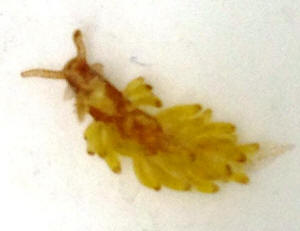 cropped and enhanced
cropped and enhanced |
Re: Nudibranch ID
1/11/13
Thanks!!!
<Welcome Van. BobF> |
|
Worm ID: Syllid within Palythoa Colony --
3/9/11
Hey WWM Crew,
<Hey Todd, Lynn here today.>
I found this little critter on my Palythoas and was wondering if
you knew what this worm is?
<Yep, it's a type of Syllid, most likely in the genus
Myrianida, that's in a reproductive phase. Syllids are
generally fairly small worms (couple of cm/<1'), that tend
to live either in the upper layers of the sandbed or above it,
where they're associated with everything from sponges to
corals, tunicates, hydroids, bryozoans, etc. It's a very
diverse group of worms.>
I am not sure if it was eating my Palythoas, but it was for sure
irritating them.
<I bet so. The last time I ran across one of these guys, it
was associated with Palythoas and was indeed either consuming, or
at the very least irritating them. I would remove this, and any
others that appear within the colony. For more information,
please see the FAQ titled 'Saltwater Polychaete ID Question:
Syllid Stolonization -- 1/19/09' at the following link (as
well as link supplied within): http://www.wetwebmedia.com/PolychaeteIDF7.htm?h=
>
My best guess would be that it is in the Class: Polychaeta, but I
am not positive.
<Right you are. It's a Polychaete in the family
Syllidae.>
Any insight would be greatly appreciated.
Thanks,
<You're very welcome.>
Todd
<Take care, Lynn Z>
|
|
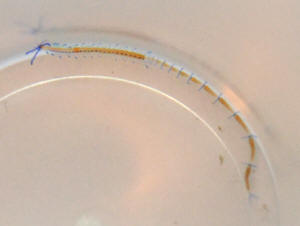 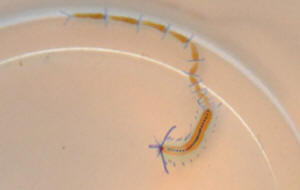
|
|
Hitchhiking Aeolid? Help ID Please... 9/23/11
Ahoy There! Alex again... I'll try to keep this one less verbose than the
past few...
<Verbosity never an issue>
As Bob suggested, I added a truly deep DSB to my sump when I rebuilt it
and have been having virtually no problems since... My nitrates dropped
from 80-100+ to down below 20ppm in about a week (the 50gal water change
undoubtedly helped but after resting and testing I was shocked at how
much difference the new sump makes) and my phosphates are below 0.5ppm
(decreased by a full order of magnitude!), so that's all good.
<Ah yes>
As promised, I will send pictures soon; I just want to let it grow in a
little and then I'll write an article for the WWM forum. I learned a lot
building my own and I am excited to share.
Anyway, while you're thinking about that, think about this (hehheh): I
recently discovered a stowaway in my tank! I know, this is all too
common on the high (maintenance) seas, but I can't figure out what this
guy is. I can tell it is definitely some kind of Nudibranch, probably an
Aeolid but for all I know it could just as easily be from the Glaucidae
family, and by my guess it is still a juvenile.
<Does appear to be an Aeolid>
It has somewhere around 4-6 pairs of brownish-orange cerata and a
milky-white-to-almost-transparent body, and it looks to be just over
0.25" long (not quite a centimeter). I do not have a submersible camera
but after many (literally hundreds) attempts I was able to deftly snap a
few halfway-decent shots through a magnifying glass and then zoom in on
the computer, which is why these chosen few images are still pretty
grainy. I wish I could offer better ones. In these pictures, the big
fork that looks like rhinophores is actually (I think) a large pair or
cerata, and the two pairs of tiny whitish prongs at the anterior end are
what I understand to be the rhinophores and oral tentacles (but these
are nearly invisible in all but the top-leftmost image).
I am curious not only because it looks so much like an adolescent
*Aeolidiella stephanieae*, but because if it's not then I'm concerned
it's probably eating the Zoanthid polyp it's been hanging out on for the
past two days (shown in the pictures).
<Likely so>
If it is a Berghia-type Nudi,
<Not likely>
then it's a bit ironic since I was considering trying to find some but I
chose peppermint shrimp instead (which, by the way, decimated the
Aiptasia in my tank in about 4 days... now if they can just survive long
enough to clean up the tiny ones that will inevitably sprout soon
after...), but I'd also like to know so that I can make a decision one
way or another as to whether I should leave the little guy in the tank
or give it to one of my FOWLR friends who actually has some Aiptasia for
it to eat.
<Maybe the latter, but I would definitely at least remove from here>
I am dubious that it is actually a Berghia though, because not only does
it not seem to have a clear activity cycle (it slowly paces around this
particular clump of Zoanthids night and day), but also because I feel
like there would probably have been more than one with whatever rock
this one came in on. I do not know how small juvenile Hermissenda
crassida specimens can be... perhaps I have one that is recently past
the veliger stage?
<Doubtful to the extreme in captivity... the water moving pumps,
mechanical filtration, lack of foodstuffs of use...>
Zoanthids are in that weird Cnidarian nether-region between a hydroid and
a coral,
<Mmm, much more toward the latter/Anthozoans>
so it wouldn't surprise me to learn that H. crassida might be eating them,
but I also can't tell with certainty that the polyp is being eaten.
These Zoanthids are sensitive enough that I find it equally possible
they would just close up because they're being crawled on, and I can't
distinguish any areas with visible damage. Unfortunately, I don't know
the exact species of these Zoas, so I can't offer much in the way of
spotlighting diet preferences to help identify this hitchhiker... I hope
this image is small enough to accept. I was trying to retain sufficient
detail in the shots.
As always, your scholarly wisdom is highly valued and graciously accepted.
Oh great gurus, what should I do?
<When in doubt I vac it out; it's a free-for-all! Bob (not Ted) Nugent>
PLAH!
Alex:D
|
|
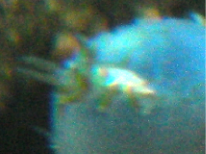
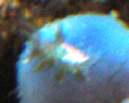
|
Hitchhiking Aeolid? Help ID Please (amendment) 9/23/11
Sorry to send multiple messages, but I just realized a grievous error in
my last note:
I mentioned that possibly my stowaway is a juvenile Hermissenda
crassicornis
because I had found a picture of a baby one (possibly misidentified, now
that I've looked around more...) that looks very similar to the tiny
thing crawling on my Zoanthids. Obviously (to you maybe) that is
impossible or at least very unlikely, because H. crassicornis comes from
cooler waters than my tropical tank and so is unlikely to have survived
long on any rocks from the LFS. But after looking at all the pictures
listed under the Family Aeolidiidae on Bill Rudman's Sea Slug Forum
species list,
<A fave>
I am still not sure what I've got. The closest match besides Aeolidiella
stephanieae might be A. oliviae, with its diet of anemones and maximum
size of ~20mm, but the ones pictured are supposedly 12mm long and they
have many many times the number of cerata I see on the stowaway, and
like the Hermissenda sp. they also seem to be from cooler water.
I will pipette it out of my DT and put it in a jar so I can try to get a
better picture.
Alex
<Thank you. Plah Bob>
|
Hitchhiking Aeolid (Better Pix) 9/24/11
Howdy Bob F. Nugent (good to know the 'F' stands for 'Fletch' haha)
<I wish I had the Chevy Chase income, and much more acting ability!>
So taking good pictures of tiny sea slugs with a marginal camera is
basically impossible, but after much diligence I was able to get
these images. As you can see, the beast has far fewer cerata than
*A. oliviae* and actually does have a faint orange stripe down its
white back, so perhaps it is closer to being a juvenile *Hermissenda*
than I thought (but if that's what it is then supposedly it can get
pretty large). I also noticed that the tips of said cerata are
indeed whitish-colored, and though none of the blacklighted pictures
were worth sending (partly because the camera battery died as I
started attempting them), I was able to clearly see green glowing
specks within the cerata, which confirms that it *was* eating the
Zoanthids (or at least eating their Zooxanthellae). I currently have
the creature isolated in a little plastic magnifier box. I still
have not seen any others in the tank, so I'm not sure how likely it
is this one has reproduced; it is probably a loner. It's too bad I
can't keep it; sure is purdy.
<Can/could... either suffer some attrition of your Zoas, risk
reproduction... or place/keep/feed elsewhere selectively>
Do these shots lend any better clues as to the species, or even
whether I'm dealing with an adult specimen versus a juvenile?
<Not really. Per BillR's excellent SSForum, you'll note that there
is often a very large range of colours/markings, variations in
size/dimensions per species, geographical distribution>
Note the edge of the straight razor placed for size comparison... If
I could confirm that it will survive eating more than just Zoas,
then maybe I could put it in my refugium and let it cruise around in
there.
<Mmm, most Nudibranchs are quite food-specific... Hence my standard
issue of collecting/purchasing ONLY w/ their food organisms>
I doubt it can lay eggs without a partner... Even if it could
there's apparently almost no chance that any young would make it
through the pumps alive.
<Not likely so>
I still don't know which piece of rock/coral it was stashed on, but
at this point it has to have been living in the tank at least a
couple of weeks
<Greatly probable>
because I doubt it was hiding on the lawnmower blenny I bought last
week.
<Highly dubious indeed>
I have examined all the other areas of Zoanthids in the tank and as
yet haven't seen any others, so hopefully I lucked out and only got
one. I guess we'll find out...
PLAH!
Alex:D
PS: Kudos for saying 'PLAH' back... most people are pretty
dismissive of the idea because they don't try to figure out what it
stands for. But I think it's the future of salutation. Now if we can
just make it the future of Foreign Policy as well...
<I do agree. Cheers, BobF>
|
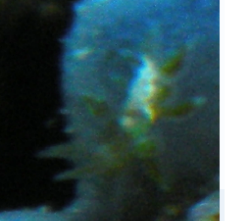 |
|
Re: Hitchhiking Aeolid (Better Pix)
9/24/11
Sorry, I neglected to attach the pictures to that last note...
<Mmm, I just cropped and optimized one of the prev.>
they probably still don't help much though... You guys are troopers.
Thanks for your help.
<Nos vemos. B>
|
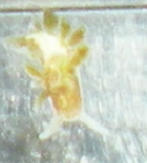 |
|
Treating the tank for Nudibranchs
4/28/10
Hi crew.
<Hi Chris>
I have read tons of stuff related to my problem. I have
Zoanthid eating Nudis in my tank.
<Bad news>
My problem is that I can't remove all of them to dip without
completely dismantling the tank knowing that the whole process will
need to be repeated to eradicate the next generation of Nudis.
<Dipping usually does not work anyway>
I have removed a couple from dipping small rocks and frags and very
rarely see them.
<They have to be removed manually. The life-cycle is typically two
--three weeks, so daily removal over this period is required. An hours
work or more a day typically until they disappear after three weeks.
Frustrating. http://www.wetwebmedia.com/corldisart.html
>
I was hoping that treating the entire tank with Flat Worm Exit
<A Planarian killer http://www.wetwebmedia.com/fltwmchemcont.htm
Nudibranchs are not Planarians. This is a shotgun approach, a
'hopeful punt' that probably won't work>
followed by a healthy water change
<Requires at least two, 50% changes, the same day, the first an hour
or so after treatment. This is NOT something I would do, it will kill
life in your system>.
and carbon would be a viable solution.
If so, do you have any specific methodology including dosage amount to
pass on to me?
<No chemicals that I know of. Quarantine of invertebrates & live
rock before adding to the main system to prevent introduction of these
in the first place. Hours of manual labour to remove once they are
in>.
Thanks for you attention to my problem.
<No problem Chris>
Chris
<Simon>
|
Blue worms eating Zoanthids
11/26/10
First off, thank you for the plethora of information you all make
public for the inquiring aquarist. I have spent countless hours
increasing my knowledge of my little piece of the ocean and your
site is definitely
appreciated. I searched high and low and couldn't find
anything on my problem. My Zoanthids are being eaten by what
looks like small blue worms.
They look similar to bristle worms but they are skinnier and
royal blue in color.
<I see your pic and concur>
They have blue antennae and look to be burrowing along the side
of the flesh on my Zoas. Any info on if they're good or
bad?
<If they're causing discernible damage to your Zoanthids,
I'd say bad. If not, no big deal likely>
As of right now I've caught two (can't see any more right
now). If they are pests do you know how I can eradicate them?
<Likely trapping. Read here re:
http://wetwebmedia.com/polychaewmcompfaq2.htm
I hope the attached photo is clear enough it's from my cell
phone so it's not the best.
Thanks,
James
<Welcome. Bob Fenner>
|
|
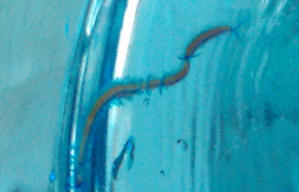
|
|
Zoanthid eating snails?
Hi Guys,
<Jorge>
I just finished searching many forums and reading through a lot
of your site.
Over the last month, I lost various Zoanthid colonies of mine.
The colony slowly but surely starts to develop a white film and
then just disintegrates (which I know is typical of infection
but...). Once I noticed this, I fragged away any healthy polyps
as best as I could and those for a while did well, but then also
withered away (over a week or so)
I also dipped the colony in CoralRx but that was to no avail
as
it continued to disintegrate. While I was fragging away some more
healthy polyps, I noticed that the colony had hundreds, or even
thousands, of these little tiny balls. I am guessing they are
some sort of egg as the balls have a mucus like substance that
keeps them together when you try to pull them off the coral. In
other words, if you pull a tiny cluster of the balls away, quite
a few more little clusters follow behind it.
Sure enough, as I started to pull the "eggs" off the
colony, under the "eggs" I found various snails. I am
not sure what they are, but I am guessing they are the culprit.
Hopefully the pictures are good enough.
I would really appreciate it if you could tell me what the heck
these things are and if you think they are guilty. And then what
I need to do to get rid of them. The CoralRx seems to have done
nothing to stop them.
Thanks so much for all the information you provide us reefers. It
is greatly appreciated by me and many others.
Take care,
Jorge
aka - Jgoal55 on RC.
<Do look like predatory snails... Please read here:
http://wetwebmedia.com/zohlthf3.htm
and the linked files in the series above, and:
http://wetwebmedia.com/pestsnailfaqs.htm
Bob Fenner>
|
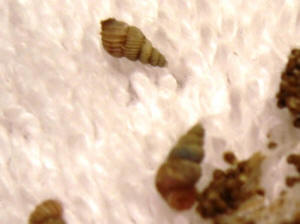 |
|
Hungry beast in my tank; makes translucent tubes,
burrows holes in live rock, and eats Zoas and candy canes!!
2/19/10
Hello WWM Crew!!
<Bruce>
First of all please let me thank you for all you do and for all
the help you have provided me in learning how to keep a reef!!
You time is appreciated by me!
<We share!>
Secondly, I am sorry to bother you but I cannot find previous
posts that show pictures of what I have. Any help you can provide
me will be greatly appreciated.
I have not been able to identify the villain(s?) I am battling in
my tank.
Here is what I know about said villain:
* builds calcium tubes about 1/8 inch diameter
* makes translucent 'tents'
* dines on Zoas.
* dines on candy canes
<The Nudibranch in your first attached file? Oh yes>
My piece-O-reef is a 20 month old system that is comprised of a
120 display and a 50 gallon fuge. Both display and fuge have a
5" DSB of large grain aragonite with a plenum. Mostly LPS
with one piece of healthy SPS.
Around Feb 7th, I noticed enough issues with my Zoas that I
decided to take action; my problem is receding Zoas and, many
months before that, physical damage (white puffy tubes or
tunnels) to a couple of my candy canes. Long ago I moved the
candy canes and had not seen the translucent tubes in months. Now
they are appearing again near a Zoa frag on the same rock.
<These tubes shouldn't be problematical. Are they
illustrated here?>
Two weeks ago I pulled a lone Nudibranch out of my fuge.
http://www.box.net/shared/xmy1x8y10q
<This is a predator...>
Also, upon further investigation of other Zoas in the tank I
noticed what I could best identify as Zoa pox (Zoas that would
not open and showed white spots around some of them) on about 15%
of the Zoas in my display. From looking around it seemed like a
fresh water dip in a 7 drop per gallon mix of Lugol's water
then a Seachem coral dip was the best course of action.
<Yes, but...>
The problem is that I removed all coral but one for treatment. I
left one frag of Zoas in the display (showed no signs of
problems); yep you guessed it now that frag is receding and
showing the tubes and now a 'tent'. You will notice the
'tent' to the left (lower half) of the frag plug.
<I can't quite make this out>
(also note the hole or 'door' at the bottom of the frag
plug)
<Nor this really>
I can remove the last frag but I assume the critter is in the
live rock and don't want to give him a chance to hide away to
haunt me another day! Do I dip the live rock and kill everything
on it? seems a bit like a bull in a china shop approach to
controlling the little bugger.
<Which? Sorry for my confusion. Are you referring to the
Nudibranch/s?
These are best removed via siphoning... the "tents" and
tubes by physical scrubbing (outside the tank)>
On the 14th I noticed an update; 80% of the 'tent' was
gone and by Sunday morning the remainder is gone. The Zoas were
still in their receded state with no visible signs of external
munching or other physical removal just a slow but steady
retreat.
<There's something else going on here highly likely...
some sort of interaction twixt your other Cnidarian life perhaps.
Ideally, after such "processing", the Zoanthids
can/will be placed in a system of all new seawater>
Other frags (on the frag rack on the wall) are fairing fine in
the tank, three types of Acans, Favia, Galaxea un-named SPS. The
Zoas on the frag rack (Mohawks and some other no-named frags)
show mixed results. I report them as 'mixed' results
because the Mohawk are wonderful but the others seem to be
enduring light shock (due to moving the frag rack around the tank
while tearing out the corals on the live rock).
I also set up my 'night-vision' camcorder to see if I
could catch any critter feasting on Zoas, no luck but boy o boy
do I ever have more 'pod' action than I imagined!!
The link to some of the night shot of the affected Zoas:
http://www.4shared.com/dir/31193171/45f3ce9a/sharing.html
<Neat>
And finally tonight I hate to say it but at this point the Zoas
are almost gone. I tired to take another picture to see if I
could get a better shot of the tubes.
http://www.box.net/shared/ne6aih85d9
To the right of the frag plug just above the middle you can
almost make out a translucent tube. The tube extends down between
the rock and frag plug.
Also, you can barely make it out but there seems to be
"chewed" or "powdered" calcium looking stuff
below the lowest edge of the plug. The tubes appear to be able to
go into the live rock so I am guessing that the critter can
'burrow'.
<... I have tried to manipulate this image... and still
can't see what you are referring to. Sorry>
Please help me identify this beast and point me to the
remedy.
Thank You!!!!!!!!!!
< I wish I could offer you more here. I would not add
more/Zoanthids to this system. I would vacuum, remove the
Nudibranchs, their egg casings. Bob Fenner>
|
 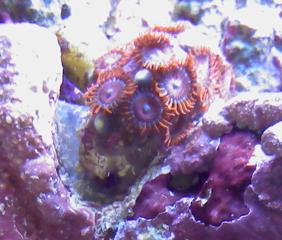  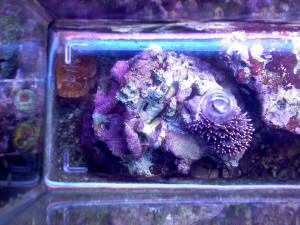 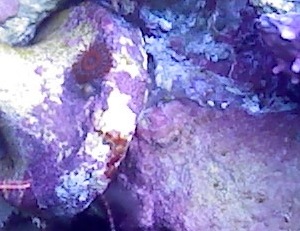 |
|
Snails: Likely Collonista Snails, Issues with
Disappearing Zoanthids -- 1/6/10
<Hello Tommy, Lynn here today.>
Help, I'm trying to ID this snail.
<Yay, I love snail ID's!>
I'm hoping it's not a Heliacus.
<I think you're in the clear. It looks like a common,
harmless, herbivorous hitchhiker in the genus Collonista,
sometimes called a 'Mini Turbo' snail. To positively
confirm, use a magnifying glass and take a good look at the
snail's operculum (the 'trap door' at the opening of
the snail). You should see a tiny pit/hole in the center. If you
don't see one, do try to get a few detailed photos and
we'll try again. Just for comparison, Heliacus spp. (aka
'Sundial') snails tend to be rather squat top to bottom,
with straighter sides, a rather heavy, almost 'beaded'
appearance to the surface, and an obvious cone-shaped operculum.
For more information/photos re: Collonista snails, please see the
related FAQ's at the following link:
http://www.wetwebmedia.com/snailidf14.htm
More here:
http://bb.wetwebmedia.com/viewtopic.php?f=25&t=242
Here's an example of Heliacus spp. snails:
http://www.gastropods.com/5/Shell_5765.shtml >
My zoo's are disappearing fast
<Uh-oh. If the water parameters/conditions and other livestock
are okay, then I'd look for either some sort of predator or
irritator, or evidence of disease. The list of potential
predators and irritators is long and includes Heliacus snails,
Pycnogonid spiders ('sea spiders'), Gammaridean
Amphipods, Vermetid Gastropods, Nudibranchs, a few crabs, various
fishes (Angels, Tangs etc.), tube dwelling Polychaetes, etc.(see
links below for photos). Your best chance of spotting some of the
smaller, and/or more cryptic individuals is at night with a
flashlight. If you're able to rule out pests, I'd look
into possible disease (pox, fungus, etc.). Take a good look at
the colony, especially the stems. Are there any light or whitish
spots present? Do the stems look fuzzy, spindly or unusually
dark? Once you determine what the problem is, please use our
Google search engine for a solution/treatment:
http://www.wetwebmedia.com/Googlesearch.htm
In the meantime, we have lots of information regarding Zoanthid
problems, starting here:
http://www.wetwebmedia.com/zoanthidhlthfaqs.htm
Check out this link for some terrific photos of Zoanthid
predators, irritators and pox:
http://zoaid.com/index.php? module=Gallery2&g2_itemId=384
>
..and I'm noticing that these snails are multiplying very
fast.
<Collonista snails can indeed multiply quickly, but don't
usually cause problems.>
These are the best pictures I could get.
<I think we're good to go with this snail. However, as per
above, if you find that what you have isn't a Collonista,
then do please let me know.>
Thanks for the help!
<You're very welcome!>
Tommy
<Take care, LynnZ>
~^~^~^~^~^~^~^~^~
| <°)))>< <°)))><
| <°)))>< <°)))><
¸¸.·´¯`·..
><((((º>`·.¸¸.·´
><((((º>`·.¸¸.·´¯`·.¸.·´¯`·...¸><((((º>¸¸.·´¯`·.¸.
`·..
><((((º>`·.¸¸.·´¯`·.¸><((((º>¸¸.·´¯`·.¸<°)))><
.¯`·.¸><((((º>
|
|
¿ >°)))><
|
 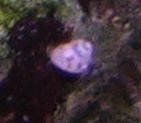 |
|
Re: Snails: Likely Collonista Snails, Issues with
Disappearing Zoanthids -- 1/7/10
<Hello Tommy, Lynn here again.>
Thanks for all of the help!
<You're welcome!>
I think it must be the asthenia snails
<You mean Asterina stars?>
..doing the damage. I guess I will get a harlequin shrimp to
combat these.
<I wouldn't, unless you're absolutely overrun with the
little stars. Otherwise, once they exhaust the food supply (of
stars), they'll likely starve to death. I would instead opt
for physical removal (tweezers work well). Please see the
following links for more info re:
http://www.wetwebmedia.com/harlshrpfaqs.htm
http://www.wetwebmedia.com/asterinafaqs.htm >
I will have to get rid of my sand star first though.
<It's possible that the star could escape the shrimp under
the sand, but I wouldn't chance it.>
I have attached a couple of pictures one is before and then you
can see what happened. The other is what the fire and ice look
like and it used to be full.
<Yikes!>
Again Thanks for the help!
<It was a pleasure! Take care, LynnZ>
|
|
All around Zoa death ... 11/29/09
Hi all:
<Michael>
Forgive my ramble a bit please!
<Is fine>
I have two NanoCube tanks, both 12g, both using MaxiJet 900
pumps. One of the Nanos is the DX, thus has the 50/50 pair of
lights for 48W of light, and the other has a Current USA 18W plus
a little 9W, both with 50/50 bulbs for a total of 27W. Water
conditions are consistently testing well within normal parameters
as far as nitrates, nitrites, ammonia, pH and alkalinity, plus in
my efforts to figure out what is going on, I have been doing
weekly water changes of 20-50%. All my Zoas were looking pretty
good for a reasonable amount of time (2 months or so) and now
they are steadily melting or completely dying.
<These and other Cnidarians are hard to keep in small
volumes>
Frustrated beyond all belief, I did a Lugol's dip yesterday
on the bigger pieces that could withstand dipping (some of my
rocks have other critters on them which might not tolerate the
dip as well) in the hope that there is some bug at issue here,
like flatworms or Zoa spiders. I looked very carefully in the
tank while doing the dip under good bright light and with a
magnifying glass to see if I could actually spot any
"vermin" but in all truth I was only able to see a
couple of 'pods and /possibly/ some flatworms at the bottom
of the dip tank.
<I've expanded and "sharpened" your image as
well/much as I can and see nothing either>
I started the second tank as I felt I was dealing with
allelopathy initially, but I fear I may have complicated matters
instead of simplifying or isolating the root cause. At his point,
all of my Zoa rocks save one are in the process of dying (or so
it seems.) There is some other wildlife in the tanks that appear
to be doing OK ... pulsing Xenias (plentiful and fruitful),
little red "rock anemones" (I don't know what these
are really, but I've included some pictures), various
mushrooms
<All three groups are tough competitors with Zoanthids>
and some cleaning crew crabs and peppermint shrimp. One of the
tanks also has a pipefish who seems to be doing pretty well.
Zoas are really the only thing that I'm seriously interested
in having - the other things are somewhat extraneous, so losing
the Zoas is quite upsetting and I don't seem to be able to
figure out what is going on.
The only things I have not tested are SG and phosphates, although
with the frequency of water changes I am doing, I don't think
these are an issue (although I could be wrong.)
<Not likely an issue>
My water is sourced from Scripps Aquarium here in Southern
California, which is supposed to be NSW equivalent.
<Mmm, was just down there three days back surfing... Not
yesterday, the waves were HUGE! And chatting with a young fellow
filling containers at the base of the pier, four sand filters...
I do hope/trust that you have a S.O.P. for storing, treating this
natural water ahead of use. Do read here re:
http://wetwebmedia.com/seawater.htm
and the linked files above>
Please forgive the terrible pictures ... I tried my best to show
what is going on here:
<I only see one>
In the foreground (fuzzy) are the Zoas that seem to be doing OK
... not great, but OK. In the background is a large rock that
used to be completely populated with green, purple and blue Zoas
- now, everything is melting dying, and the back half of the
piece is completely naked now. I know this is hard to see ... my
apologies!
Here is a picture of one of the rocks with the "rock
anemones" on it ... these appear to be doing well on this
rock. Above this rock is another rock which was moved back into
this tank from the second tank; it used to look even more
"full" than this, but everything is now retracted or
dying:
<Mmm, well... I can't tell/discern what the issue/s might
be here leading to the Zoanthid die-off, but I do know how I
might proceed... I'd drain one of the 12 gallon systems,
carefully (with gloves, eye-protection, outside the system) break
off some of the good/clean/live Zoanthids and re-stock the newly
cleaned systems sans the other groups of Cnidarians>
Using a turkey baster and blowing off the residue, I find that
there are little circular white "rings" that blow off
from around the base of the Zoas ... I can't really tell or
know if these are eggs or webs or what.
<Likely dead tissue from the Sea Mats>
Does this give anyone any ideas on what I'm either doing
wrong or what is going on? This is really driving me to the point
of giving up - I'm normally quite patient and willing to try
and figure things out, but I've done everything I can
possibly think of (albeit from a somewhat newbie
perspective.)
<Unfortunately no... only can guess>
Thanks so much! Let me know if there are more specific things
that I can address/look for.
Michael
<Other than the collective experience we have recorded on WWM
re these organisms, I have nothing further to impart here. Bob
Fenner>
|
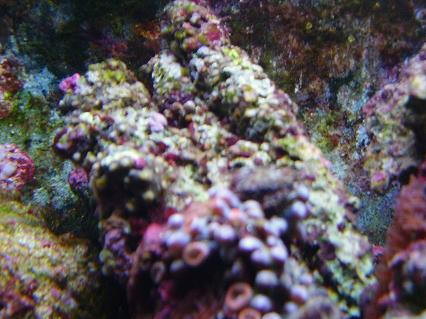 |
|
Worm living inside my Zoa 10/26/09
????
A while back I took some pictures of this worm looking thing
coming in and out of my Zoas, here it is:
This was a while back and eventually I stopped paying attention
to this.
But for the past few days the Zoas have been... not extended to
their full potential and I picked them up to take a close
look.
I saw something that caught my attention. It looked like a shell
that was growing between the polyps. I got a tweezers and broke it
up, turns out to be a tube. Yeah, it looks like there's tube
growing into the Zoas!
<It's just a hitch-hiker tube-dwelling worm of some sort
or another (further ID unlikely). It's nothing to worry about
and not why your Zoas are not extending.>
You can see it right in the middle
WHAT IS THIS?!
<See above.
Cheers,
Sara M.>
|
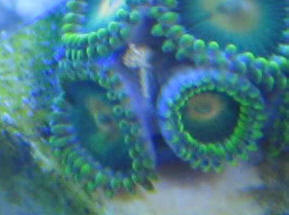 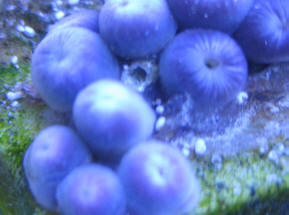 |
|
Nudibranch ID help
05/29/09
I can't find a match for this lil critter, the Nudi.s
body is apprx. 1/4 "long. Thank you, Paul
<Hmm, can you give us any more information? Did you find this
little guy on one of your corals? What corals do you have?
Cheers,
Sara M.>
Re: Nudibranch ID Help: Zoanthid Predator --
5/30/09
<Hello Paul, Lynn here this afternoon.>
I recently set up a new tank, it was a hitchhiker on one of the
frags
<Betcha it arrived on the Zoanthids.>
... it was on the glass, if you zoom in it is actually a
beautiful Nudi
<Yes, it is.>
..but I have it in a specimen cup till I can find out if it is
safe in the tank.
<Good, because it's definitely not safe around your
Zoas.>
It was on the glass not a coral
<Good. What you have looks very much like a notorious Zoanthid
eating Nudibranch. They're mostly a brownish/orange and
white, but take on the color of the Zoas they're preying
upon. For more information, please see the following link,
starting at 'Re: Polyp-feeding Nudibranch' all the way
down through the 'Re: Perhaps a gorgonian feeder?' posts:
http://www.seaslugforum.net/showall.cfm?base=palyfeed
Terrific photo:
http://coralpedia.com/index.php?module=Gallery2&g2_itemId=641
More photos, showing color variation:
http://coralpedia.com/index.php?module=Gallery2&g2_itemId=415
I'd keep a close eye on your Zoas for any indication of
predation or signs of additional Nudi.s. If you see either,
please refer to WWM's FAQ's for removal tips. Just enter
Zoanthid Nudibranch in the Google search engine:
http://www.wetwebmedia.com/Googlesearch.htm
>
..but I have frags of Zoas, pipe organ, Montipora danae,
chalices and good ole GSP in that tank.
<All but the Zoanthids should be in the clear -- at least as
far as these particular Nudi.s go! Take care, LynnZ>
|
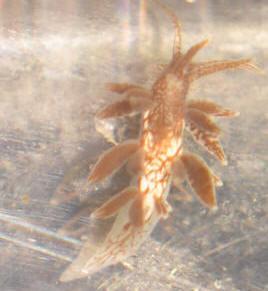 |
|
Snails, Zoa Deaths, and good pix. 02/11/09
Howdy! First off my wife and I had the pleasure of meeting Mr.
Fenner in Dallas at the Next Wave 2009 event. He gave the most
dynamic, and informative presentation. The other presenters had
good info, but they were geeks ( in a good way, really :)
<Thank you for saying this re Mr. Fenner's presentation. I
always try to tell him he's the best, but he thinks I'm
just "sucking up" or something. I've been to a lot
of marine aquarium conferences/presentations, and many are
interesting... but (imo) none are as equally informative and
entertaining/well presented as Roberto's.><<Ho buoy!
RMF>> Now for my questions. 1: Our Zoas are dying off in
patches. We have tried RO and Lugol's dips to make sure we
don't have spiders or any other evil critters. Well, we found
Sun Dial snails. How the heck do we get rid of them? <You have
to quarantine the Zoanthids and meticulously remove all the
snails... and, as gently as possible, scrap off all the snail
eggs.> We removed 3 or 4, but we keep finding one or two every
now and again. We really want to put more Zoas in, but when?
<You need to quarantine the infected colonies asap. I
wouldn't add anymore Zoanthids until you haven't seen any
snails for at least 2 weeks.> 2: We set up a pico tank and
found the coolest hitch hikers. We think the coral is a
Caulastrea. It is in bad shape, but seems to be getting better!
The other is a beautiful snail, any ideas on what it is? Is it
evil? <It's difficult to ID snails from photos... but I do
think this is one of the Nerite sp. of snails (usually
beneficial).> The pix are attached. You can find the originals
at
http://william1034.smugmug.com/gallery/7329746_Q9Y4q/1/471608269_j6LtS
We are still learning so please leave comments with the pictures.
William <Cheers, Sara M.> Btw, you might want to collect
those snails and sell/give them to someone with a Zoanthid
"problem." I do recall going around with a friends,
actually looking for these little guys because their Zoanthids
were growing out of control (as tends to happen). Though
they're a pest for those just starting out with small
Zoanthid colonies (and for those in love with these corals),
they're actually appreciated/welcomed by some with more stony
coral focused systems (that happen to have some stray Zoanthids
run wild). Cheers,
Sara M.
|
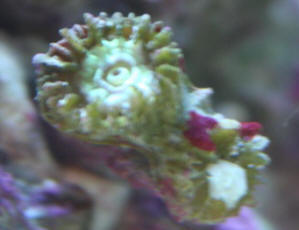 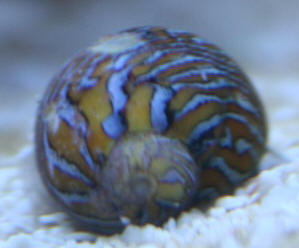 |
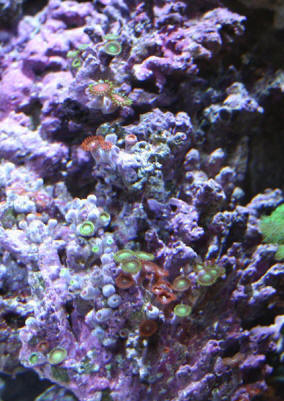 |
Help! Zoa eating nudis -03/16/08 Hi, I hope you
can answer an urgent question- I recently noticed Zoanthids
disappearing. Today lost several bam bams. I spotted 2- 1/4 inch long
green nudis. Googled them and identified them as Zoanthid predators. It
said to use flatworm exit. I have some used it before and a different
tank. I need to know if this will hurt my RBTA. <The problem with
these types of broad scale "medications" is that you never
really know what they're going to affect in a reef tank. It might
hurt other animals in your tank indirectly. It will kill any flatworms
you have (benign or otherwise) and this could also hurt other animals
in your tank (some flatworms are toxic upon death).> The package
material says it is safe for reef inverts but I would feel better if I
got an expert opinion first. <Expert opinion? Hehe... will you
settle for mine?> Need answer quick, those buggers are munching away
at my Zoas as I type. <My advice would be to remove the Zoanthids to
a quarantine tank, and try your best to remove all the Nudibranchs by
hand (with teasers under a magnifying glass) and also find and scrape
off all the eggs (cheap dental tools you can get at a pharmacy work
well). The problem with using flatworm exit for Nudibranchs is that you
usually have to use a dose on the order of 5 to even 10x the
recommended dose. And who knows how safe or not safe such a treatment
is for a whole tank? I wouldn't risk it. If meticulous removal of
the pest doesn't work, I would try the flatworm exit, but only in
isolation (if possible).> Thank you so much in advance Linda Mecher
: ( <Good luck! Sara M.> <<RMF would try the "usual
assortment" of probable small predatory wrasses here as
well.>>
Bristle worms and Zoanthids -01/29/2008 Hi Guys, I
did a quick search on WWM but couldn't find anything quickly. I
just added a very small frag of Zoanthids (after a 10 min dip in
Lugol's soln.) into my main tank. This afternoon I got home from a
long night shift and found at least 4 sm. bristle worms crawling around
them. I pulled off 4 not sure they were good or bad for the Zoanthid
and I am completely exhausted from my night shift. Could you just tell
me if bristle worms attack or have a symbiotic relationship with my new
little frag? <Neither really, they typically just coexist in
peace.> I really appreciate it. Thanks, going to bed now. Erika
Villanueva <Sleep well, Sara M.>
copods and polyps... comp.? 12/1/2007 Hi
all, <Zac> So I have an abundance of copods <... there is no
such thing> in my 24gal tank, I have seen a slow decline in my daisy
polyps, meaning that they have been slowly disappearing from my once
large and healthy colony to a very small colony. My water quality is
<20ppm nitrates, 0 nitrites, 0 ammonia, 8.1 ph. I do 5gal/25% water
change every two weeks, so I don't think that it is my water
quality. Anyway, I keep seeing tons of copods in my tank, seeing that
they have no predators, because I only have 1 sandsifter goby in my
tank right now. I see the copods all over the daisy polyps at night,
and also on some red zoos that I have, which are also starting to
diminish. On the other hand I also see some tiny blue star fish that
are on the daisies and the red zoos, so that might also be the problem.
But I have no clue. Thanks, you guys are great. Zac <... What else
is in this system stock-wise? What re your supplementing, feeding
practices? Could be that these small crustaceans, copepods or otherwise
are predaceous... BobF>
Zoanthid eating Nudibranchs 11/30/07 I
recently found quite a few Zoanthid eating Nudibranchs in one of my
tanks, we have a few that are plumbed together. We have pulled off as
many as we can find, dipped them in an iodine solution and pulled off
all the egg spirals we can find. <Good> The colonies that are
infested are in QT now. My question is this: when the eggs that we
haven't found hatch do they have a free swimming larval stage, and
if so would a UV sterilizer prevent them from making their way into my
other tanks. <No> Is there anything I can do other than
quarantining them and pulling the Nudibranchs off with tweezers? Do you
know of any fish that would eat them that I could add to my tanks?
Thanks for all your help. Amanda <"Eggs develop and hatch as
free-swimming veliger larvae with a rudimentary coiled shell. The shell
is lost with the larvae metamorphosing into a miniature adult settling
on the bottom." (WWM) More rapid, complete physical filtration
might sieve them out. Bob Fenner>
|
Blue Zoa BUGS!!! 8/20/07 Hey crew, Thanks in advance
for all the info already given and provided to us all. Your
site/info has been a great resource for me and am sure for
others. I am wondering if you could ID these bugs I recently
found on my blue Zoas. These bugs seem to make the polyps close
randomly in groups. Getting a great picture if these bugs has
been tough without sucking or attempting to suck them out with a
baster. Less than a millimeter in length, clear, has 2 antennae
coming from its head, has multiple legs cant tell home many
because its so small. The Zoas and the rock are teaming with
these bugs. I have attached a picture to help, don't know how
much help it might be. I can always suck one out with a baster in
order to get a better picture if needed. Thanks for all the help
for giving me a good understanding of what is needed in order to
take care of and maintain a marine Aquarium. <Mmm... well...
there are a few approaches to control here... with the usual
"range of desirability"... biological, physical,
chemical last... You can/could interpolate these by a cursory
read here: http://www.wetwebmedia.com/swmitefaqs.htm Do you have
another "isolation" tank that you might use to
eradicate the bulk of these pests? Bob Fenner.
Re: Blue Zoa BUGS!!! 8/20/07 After
reading am not to concerned about these bugs just the number of
them and the Zoas not opening or only opening for a shirt time.
Well, I have am still working on the tanks filters, its an all
glass not drilled tank and invested in an overflow with
Aqualifter pump, I had plans to have a isolation tank plumbed
inline back to sump for an isolation tank. At the moment it is
not set up. I do have a 10gal tank sitting around. Thank you.
<I do think you're wise to ignore these for now. Bob
Fenner>
Re: Blue Zoa BUGS!!! 8/24/07 Thank you for
all the help you have been, I think for now I will tolerate the
spiders, but if continues to be a "major" problem which
already seems to have lessoned I will be adding a wrasse. Thanks
again Bob for all the help. -Jay
<Welcome my friend. BobF>
|
|
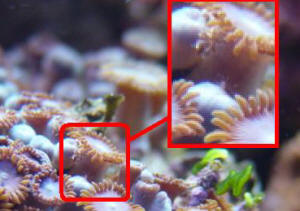
|
|
Re: Blue Zoa BUGS!!! 8/22/07 I could have told
you that Bob! Joking aside I should have mentioned I did move
them to a quarantine tank anyways, despite the lack of concern.
Thanks to you all wise one, really thank you. Am i better off to
leave them in quarantine till they are gone or population
diminishes? Also since moving to quarantine I have been able to
monitor the Zoas more closely. There are a few white worms with
black spots maybe reverse black with white spots curled up on the
sides of a couple closed Zoas, probably more on the underside of
opened Zoas. also 3 maybe 4 long red stringy worms, almost looks
like a piece of red hair flopping about over the sand, coming
from under the rock which the Zoas are growing on. My question
now is what would be better for the Zoas. From my understanding 2
ways would either be Interceptor or freshwater dip in RO water,
adjusted ph and temp of coarse. With addition to these new
findings of critters which is better to elevate the problem,
interceptor or freshwater RO dip? <Mmm, FW... pH-adjusted...
but... I see in your next email that these may be "something
else"... Pycnogonids... do they have eight apparent legs to
your eyes as well? If anything, I'd go with a purposeful
predator here (Lined Wrasse sp. likely)... or just tolerate them
if they were mine...> Sounds like ro dip would be better but I
am worried of specimen loss, and I am wandering if the Zoas will
be able to handle the additional stress levels from a freshwater
dip. Thank you wise one, Bob, for making me reconsider my
previous statements/actions/concern. <Mmmm, BobF>
Re: Blue Zoa BUGS!!! 8/22/07 Once I put it
in Quarantine I was able to get better photos, I have attached 2
pics, to show the infestation and 1 showing the actual
"bug" itself which turns out looks more like a
grasshopper, a very small grasshopper. <... or a Sea Spider...
Please read here: http://www.wetwebmedia.com/pycnogonids.htm and
the Related FAQs file linked above. Bob Fenner>
Re: Blue Zoa BUGS!!! 8/23/07 Thanks
for the quick reply once again. Figured you were tired of hearing
from me, the unwise. Well I see eight legs very hard to determine
but definitely looks like there are 8 legs. I noticed when I
first put the Zoas in my main tank my Pseudochromis fridmani
(spelling?) was picking at the rock, not to sure it was eating
anything or not. If I were to get a 6line or a line wrasse
I'll run into compatibility issues correct? <Mmm... in a
tank this size, I give you good odds of not having real trouble
here> 75gal 110lbs live rock. I fear with me having the
Pseudochromis fridmani (was my first fish), already has his
territory staked out pretty much all the rock on the bottom half)
that he will go after a lined wrasse if introduced into my
system. I notice with some research to use caution when putting
these 2 species together, as long as they don't resemble each
other, or need to be introduced at the same time? <The Lined
Wrasses are pretty sharp, and fast!> Combination of both? Or
just plain luck or am just stupid for even trying to put these
species together in the same tank. I would just as easily return
the Pseudochromis fridmani (AND THE TWO 3 STRIPED DAMSELS!!!!)
but I can not. Girlfriend picked them out for our first fish so
kinda stuck with them till he dies (hmm.... gives me an idea,
j/k). Thank you Bob you have been of great help. -Jay
<Welcome Jay. BobF>
|
|
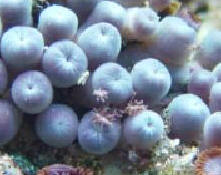 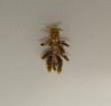
|
Zoas hlth. 4/24/07 A few days
after buying some Zoas the colony died off. Now I have
white spots on my remaining colonies, which appears to be tissue
damage. It reminds me of chicken pox. They
don't show in photos, too small, but appear to be growing. They
don't move. Please help identify and suggest a treatment. <What
type and wattage of lighting are you using? Strong halide lighting can
induce a condition that sounds similar to this?!> What is the best
method for dipping Zoas? I currently use an iodine dip. <No special
requirements, just drip acclimation> Ken <Olly>
Re: Zoas hlth. 4/24/07 After
investigating further, it appears to be some type of small snail.
<Possibly young Heliacus? See here - http://www.reefs.org/hhfaq/snails/photoalbum_photo_view?b_start=1>
Ken <Olly>
Zoanthid spiders, Pycnogonids, MgCl2
dipping... 4/18/07 Hi, I know
you have talked about these before, but I couldn't find the answer
to my question on the previous forum. I
am a newbie and did not know that I should QT corals (I know better
now). Somehow, somewhere, I have picked up Zoanthid
spiders. <Pycnogonids... some of which do feed on
Zoanthids... some are "just" space commensals...>
So far, I have FW dipped the affected
zoos, dipped them with coral dip <... what is this? Oh,
the Kent Product... mainly I2 cpd.s> and QT'ed
them. They have been in QT for about a month. I
didn't see anything for the last month, but recently began to
notice that some of the zoos looked puny and were
drooping. Tonight about 2 hours after lights out, I turned
on the lights and saw a baby spider. I immediately FW dipped
the zoo and got another. I dipped all the zoos in the QT and
got a couple more. I have had about enough. This
is so disappointing. I finally just tossed the affected zoos
tonight. <?!> I am writing because
I am worried about the zoos that dipped clean on the first go
round. I left these guys in my DT and they seem to be doing
fine. I plan on doing another FW/coral dip tonight on the
ones that are not attached to rocks and see what happens.
If I find more spiders, what should I do?
<Remove, and dip (in a 1.024 or so spg MgCl2 (Magnesium Chloride)
solution (made with clean freshwater...) for half a minute... place all
in a new, non-infested system...> I have several colonies that are
attached to base rocks in my tank. If I find spiders in some
of the colonies should I take out the base rock and dip/QT it too?
<You could... but starving these Pycnogonids out will do the same...
just leave them, the existing system w/o food for a month or
more...> I probably weighs about 20#.
I hope you all can help me decide what to
do. I love this hobby but am getting very close to bailing
because of the disappointments. I also received some
flatworm infested Chaeto from my trusted LFS. Now my
refugium has a few of them. What should I do?
<Read... on WWM re...> Will a
sixline wrasse help at all? Will they eat these things?
Thanks,
Miri <Read on my
friend, read on. Bob Fenner>
| Re: Zoa and Amphipod Problems... Unrelated
3/21/07 Hello <Hi! Mich here.> I
read through a bunch of text regarding predatory
amphipods.. There seems to be some conflicting info
about whether they are carnivorous or not.. I'm
having problems with some Zoanthid colonies ceasing to open during
the day... Some of the colonies were originally 50-60
polyps and reproducing extremely fast.. About a week ago
they stopped opening.. The first day they didn't
open I did a 10min freshwater dip to check for
nudi.s... Nothing showed up at all.. I placed the colony
back in the tank and waited until the evening still
nothing.. About 2am I check on them
again. My main lights are off at this time so It's a
little hard to see.. There are about 40 of these
"amphipods" (I'm not really sure what they are)
swarming all over the colony that stopped opening plus 2 other
colonies.. I watched them for a couple of minutes and it
definitely looks like they are pulling off pieces of the
Zoas.. <Mmm, pulling off algae.> My tank
parameters are as follows.. Bare bottom 33g, 60lbs of
rock, EuroReef 5-2, 150w heater, Seio 620, 150w MH de
pendant.. The sump is filled with Chaetomorpha.. kH
10-12 calcium 450 <Allow to drift under 400> magnesium 1300
Ph 8.0 ammonia 0 nitrite 0 nitrate > 5 temp 77-78f I was hoping
to find out for sure if these things are eating my
Zoas.. <No.> I'm also looking for suggestions
for control of these critters.. <Not
recommended.> Maybe some sort of Wrasse.. Any and all
info would be much appreciated.. I'm providing a
link to a picture of them.. I'm not sure how to
attach it to this email.. I originally tried to take a
pic of them in the dark with flash and they all
scattered. The pic came out all blurry so this is the
best I could do.. A couple of them came back after a few
minutes so I snapped this picture.. http://i30.photobucket.com/albums/c306/fishnfst/evilpods99.jpg
<A very nice photo. These are scuds (Gammaridean
amphipods) and are not the source of your
problems. These are harmless, beneficial
creatures. I suspect you may be seeing them scrap algae
of your Zoanthids. I am not sure of the cause of your
problems, but I have found that increasing the circulation to these
closed up Zoanthids can help. You might try adding a
power head and checking your outlets, perhaps your circulation has
been unknowingly reduced. I hope that
helps. -Mich> |
Re: Zoa and Amphipod Problems... Unrelated
3/21/07 Thank you very much for the prompt reply
Mich.. <You are most welcome!> I did remove one powerhead
from my tank recently.. I thought I had too much flow
with two Seio 620's and a Koralias
2.. The tank is only
24"x20"x16"tall.. Flow seems adequate still with
only one Seio 620 and my mag3 return pump... I will add
one power head back to see if it helps.. <Hopefully it will!>
Off Topic: I appreciate the easy going and concise
answers. I was originally apprehensive about sending my
question due to fear of getting my grammar and spelling ripped
apart in an open forum :) <No need to fear! Underdog
is here... Oh wait, that's something else! There
really is nothing to be apprehensive about. If there is
an effort made to follow the posted directions you won't have a
problem. But you would be surprised by the blatant
disregard for requests of proper grammar and spelling we
receive. We get queries filled with "i this"
and "i that" or ALL CAPS or just chat room speak
"cuz it ez". We do not want to post anything
in this format. We use these queries to educate and help
others. It must live up to a certain standard to achieve
this goal. We are all volunteers and it is time
consuming to fix all these problems. After a while it
can get exceedingly frustrating, especially for Bob, who has
dedicated thousands upon thousands of hours of his life building
this site. We provide a free service and ask for very
little but an attempt to keep things on a level where all can
understand and benefit.> Thank you for going easy on
me.. <No worries my friend.> If you can post the
pic to my reply it would be much appreciated as well.. <Oh, but
of course!>. Thanks Again,
<You're welcome again, -Mich>
Doug |
|
/Amphipods/evilpods99.jpg)
|
| Snail ID: Possibly Sundial snail (Heliacus
sp.) 3/3/07 Good Afternoon, <Good Morning I
guess! Mich here.> While having coffee this morning I
observed a moving speck, which turns out to be a snail. <What
good eye you must have!> At present my aquarium houses two
Astraea and three Turbos. Also there have been no recent additions
in the last three months to account for recent hitchhiking. The
shell on which the snail is perched is app. 1"x1 1/2" to
give some idea of scale. Thanks in advance for any information,
<Hmm, Is a bit small, but does look an awful lot like a Heliacus
snail, which are predatory on Zoanthids and typically
nocturnal. Do you have any Zoanthids in your system that
are experiencing any difficulty? See this page, next to
the penny: http://www.wetwebmedia.com/polypdisfaqs.htm Heliacus
snails have a small pagoda shaped operculum (trap door) this may
help with identification. Hopefully is not a Sundial
snail (Heliacus sp.)! -Mich> Jane |
Re: snail id: Possibly Sundial snail (Heliacus
sp.) 3/4/07 Mich and crew, <Hi Jane! Mich with
you again.> Thank you for the link to the image--the wee bugger
in my tank bears a striking resemblance to the Heliacus. <Not
good.> Unfortunately, due to its small size and my lack of x-ray
vision, the operculum was/is too small to see.
<Magnifying glass?> Difficulty with Zoanthids is now past
tense--little left but a rock and red stubs. <Uh oh!> But,
thanks to you, I can see the light--now if I can only see the
snail(s) again... <Hee!> Regards to all,
<And to you and yours. -Mich>
Jane |
|

|
Little crawly critter I.D. 1/28/07 Hello Bob or Graham,
<GrahamT again, Steph. Did you miss me?> This is Steph. I had a
few "green bubbles" on my button polyp, which, after looking
on your site resembled bubble algae. Removed those, only a few.
<Hope you read on the preferred method for "bubble algae"
removal, using a siphon, etc.> Now, I see some whitish, long, and
slender "bugs". Some of them are on the sides of the tank and
some crawling on my button polyps....are these a good thing? <Hmm,
still would like to see these, rather than go on a verbal description.
I am inclined to believe that you are ok, though. -GrahamT.>
Steph
Hair algae, P. diadema, and Zoanthid rejuv. 1/25/06 Hello
folks, <Deb, glad you could join us.> Thanks so much for all of
the helpful information. <We *try* to be helpful!> In the next 6
months, I'm going to be upgrading this tank to between a 150g and
250g system. At that point, I will make my 55g into the sump
for the main tank. I will either section part of this off
for a refugium, or I've got a 20g that I can hook into the system
as a refugium. When I do this, my canister filter will go
away, and I will be implementing a DSB in the main
tank. Until I can do this, I plan to continue weekly 20%
changes (replacing one section canister filter media each time),
continue aggressive skimming with the CPR BakPak, and continue to
ensure that the current in the tank is strong. <Very glad to hear
that you are moving beyond canister-filtration. You will be moving into
a much more versatile/useful configuration.> At this point, my Cyano
problem has seemed to cure itself. In doing the weekly water
changes, I found that the pump servicing my SQWD system was
clogged. This was inhibiting water flow significantly in the
tank. Now that I serviced it, there's a pretty strong
current in the tank, which probably helped to eradicate the Cyano
growing in the tank. <Most likely, this helped a
lot!> Also -- my Halimeda is making a comeback, though I still need
to continue cleaning hair algae off of it every couple of
days. The bubble algae is still present in the tank, but
somewhat manageable, as I can gently pull it out during water changes
and dispose of it. <Are you sure you have bubble-algae? Sometimes, I
think folks think BGA is bubble when it has gaseous packets in it's
layers...> So, the only real problem in the tank is the hair
algae. It's still growing quite rapidly. In
trying to fix this problem, my bicolor blenny stopped eating and has
"disappeared" in the tank. <Maybe he needed a
vacation. Heck, if I had to eat hair algae...> I'd like to
pickup a lawnmower blenny to replace him and to help with the hair
algae problem. <Remember, Deb: This is dealing with the symptoms of
a water-quality issue. IIRC, your last phosphate test was .03ppm, and I
was asking how sure you were of the accuracy of that result. Where do
you stand now? Did you ever buy a new kit?> Once the hair algae is
gone, I plan to supplement his feeding with various algae foods (as I
already do for my Coral Beauty). <Should pose little problem with a
little research...> Adding him will result in having the following
fish in the tank: 1 coral beauty, 1 Dottyback (Pseudochromis
diadema), 1 yellow-tail blue damsel and 1 lawnmower
blenny. Does this seem like a sound decision to add this
fish? <As long as you aren't hoping for a total massacre on the
hair algae, yes. In my experience, algae-eaters always choose to ignore
the one thing you bought them to eradicate.> Otherwise, my Zoanthids
have stabilized a bit. They're not dying off anymore,
but they're not flourishing as they've been for the past few
years. Only a handful are opening up, and not fully at
that. <All this points to a water chem. issue to me.>
I'm hoping that they are on the road to
recovery. I'm supplementing the daily feedings now with
Cyclop-Eeze, in hopes that the added nutrients will encourage their
growth. I also use a plastic turkey baster to blow water
over them with each water change to try to free them of the hair algae
that grows around them. I've ordered new test kits for my
phosphates, silicates and nitrates, and they should be arriving any day
now. <Ahh, very good. A reputable, reliable
manufacturer, I hope. Mmm, one note: Silicates aren't a factor
unless you have huge diatom blooms, so worrying about the
concentrations is moot IMO. I don't own a silica test kit.>
I've taken the water changes down to 1x per week, 20% using RO/DI
water. I've just gotten new cartridges in for the RO/DI
unit and will be replacing them this week. I've also cut back my
lighting schedule, taking 1.5 hours off the back end for both the
daylight and actinic lighting. <Good steps, all.> In doing all of
this work, I've realized that I haven't replenished my cleanup
crew in years. I've still got about 10-15 Astrea and
turbo snails in the tank, but all of the small crustaceans are
gone. I'd like to replenish this crew, but am afraid
that any crustaceans I add will be decimated by my Pseudochromis
diadema. Any ideas on what types of inverts I can get to
replenish this crew that will survive the presence of the Pseudochromis
diadema? Having a well stocked cleanup crew may also help
with the algae problems in the tank. <Hmm... I never worried about a
P. diadema bothering hermits to the point of murder. Types and
compatibility of hermits is not a strong-suit of mine, but I know we
have the info here on WWM if you look for it.> So, to summarize:
-Lawnmower blenny for this tank -- good or bad idea? <Good, in your
case.> -Any ideas on how I can nurse my Zoanthids back to health?
<Provide optimum water conditions: temp, movement, quality, feeding,
lighting spectrum/duration.> -Any ideas on how I can supplement my
cleanup crew without buying an expensive smorgasbord for my
Pseudochromis diadema? <Mmm... *I* don't see a problem with the
"generic" red-legged hermits here. (RMF strike me down if I
am in error)> Thank you so much for all of your help.
<Oh, Deb. You know we love you. -GrahamT> Deb
Hydroids infesting my Zoanthids? Dear Crew, <Russell>
Here's a new one for me...maybe you also? <Could be> Over the
holidays my Zoas (four frags, about six months old and previously
healthy) closed up and became infested with little critters. My Ca and
dKH dipped mildly when I was out of town for three days, but otherwise
the tank was stable.. (need to get a calcium reactor, my 2-part dosing
pump is temperamental). These parasite-like things attach to the closed
polyps and are too small to photograph accurately. They look like a
small (1-3mm) hydroid-ish creatures, having a clear stalk with small
white-brown tentacles. They start like white little dots and grow
pretty fast, spreading to all colonies and show tiny tentacles. I had
hydroids on my tank walls last year, but they went away after a month
or so. <Typical> Last week I removed the frags (some had already
grown on to surrounding rocks) and did a 15 minute dip in a gallon of
tank water with a salinity of 1.015 and over a tablespoon of
Lugol's... at the same time blasting the frags with a turkey
baster. This seemed to do the trick upon reintroduction... most polyps
re-opening and looking good. <Good> Then, over the last two days,
the little critters came back so last night I re-dipped the frags- same
as above except for 30 minutes AND I followed this with a flash RO/DI
water dip. I also pruned and discarded the remaining small amount of
new growth- polyps left behind on my LR (figuring these small
stragglers were still infected and causing the problem). <Mmm...
much more likely to be residual animals in your system... really need
to dip, move the Zoanthids to another setting> This morning the
frags, for the most part, are open with no obvious critters. Could
these be hydroids?? <Oh yes> I've searched this site (and
others) and am confident it is not "reef pox" which is more
pustular, ulcerative in nature. If these apparent parasites come back,
any other ideas???? <Mmm, plenty> Interestingly, I also recently
picked three Nudibranchs off the Zoa frags. I don't think the
infestation is from Nudi eggs. Also, they are not Zoa spiders. Thanks,
Russell in KY <Hopefully gone for good this time. Bob Fenner>
Zoanthid Eating Nudibranch...Not Hydroids After all! -
01/25/07 Dear Crew, <<Hello Russell>> A couple of weeks
ago I wrote to you that my four small Zoanthid rocks in my 11 month old
tank were infested with hydroids. You offered good advice.
Upon further observation, and research, these are actually small
Nudibranchs. <<Uh-oh...not the "better" option>>
They are about 2-6 mm in size, light brown, and very, very annoying.
<<Indeed>> I dipped the four colonies in fairly
concentrated Lugol's with a SG of 1.014. Then I did a
flash FW dip. I don't have a pH meter, so I just added a
small amount of tank water to the FW; hoping to buffer as well as I
could. <<Not likely much of a factor here>> It seemed to
work. All zoo colonies opened up and did well. <<Hardy
little buggers those Zoanthids>> But now- really, based on my
research, not much of a surprise- two have the little creeper's
back on them. <<Yep, a few adults/egg strings were probably still
in the display while you were nuking the rocks>> My next step is
to remove all four rocks and place in my QT, with periodic dips.
<<A good move, though I would only perform the dips if/when the
Nudibranchs are sighted>> The nudi's only seem to be going
after my zoo's, and not my softies or LPS. <<They are likely
"obligate" feeders on the Zoanthids>> No SPS in my tank
yet... and certainly not until I take care of these
Nudi's. I have heard Nudi eggs are hard to kill (I am a
family physician and have the same problem getting lice eggs out of my
patients' hair)? <<Usually more "resistant" to
attempts to eradicate, yes...but I think your plan to remove the
Zoanthids from the display will allow any remaining eggs to hatch and
die out...not unlike leaving a tank fallow when treating an Ich
infestation>> Besides Lugol's (which, I swear, has to be the
same Iodine I use to clean wounds in my office), <<Ahh, but it is
mate! Lugol's Solution (named after the French physician
J.G.A. Lugol's...and also called IKI (Iodine Potassium-Iodide); Iodine,
Strong solution (Systemic); and Aqueous Iodine Solution BP) is a
mixture of 5% iodine (I2) and 10% potassium iodide (KI) in distilled
water with a total iodine content of 130 mg/mL>> any medicated
dips you can suggest? <<I think the Lugol's is fine>> I
suspect the only thing I can do is QT, do freq dips and, essentially,
use tweezers to pick them off for the next, say, three to five years...
<<Ha! At least you have a plan [grin]>> It's
ironic that hobbyists have the hardest time keeping the large, pretty
Nudibranchs alive and, at the same time, can't seem kill off these
prolific little buggers.... the Aiptasia of slugs. <<All comes
down to providing an adequate supply of the appropriate foodstuffs my
friend>> Thanks, Russell in KY <<Always a pleasure to
assist. EricR in South
Carolina>>
Zoa Spiders 11/27/06 Hi,
<Hey Shelton, JustinN with you today> I have an outbreak of Zoa
Spiders in my 99% Zoanthid tank (70gal) I have used the "dip"
on all new comers, although up till now I have never used a QT for
corals :( <Better late than never, I always say :)> I have setup
a QT & removed all my Zoas from the main tank, fresh water (pH
adjusted & temp)/Lugol's dip on them, & found approx 40ish
spiders in all! I have searched all over the Net & posted on forums
both this side & is the US, but no-one really seems to know much
about these spiders? <Mmm, a Google search for the term
"Zoanthid spiders" turns up many results on many forums>
Sooooo I'm hoping you might help in the reproduction (do they lay
eggs on/in the polyps or do they keep the young with them until big
enough to fend for themselves? <Yes, they do lay eggs in the polyps
themselves, but I don't think there's any tending by the
paternals. I believe they hatch, and eat the Zoanthid from the inside
out.> Secondly I've been checking the Zoas after lights out
for more spiders, so far have not found any, but I'm thinking of
dipping them all again after say 10-14 days to make sure? <I would
do an additional one at 5-7 days of QT just to be safe> Finally
(sorry) <no worries> how long do you think it would be wise to
leave the main tank free of Zoas so if there are any left in there
they starve to death? I was thinking 4-6 weeks possibly? <I
can't seem to find any information on this, incidental or
otherwise. Likely, after the 2 week quarantine, you will be fine, but
if you have the facilities to wait out a full 4-6 week fallow period,
it wouldn't hurt.> Many Thanks, Shelton (UK) <Glad to be of
help, Shelton. Good luck on getting those nasty suckers out!
-JustinN>
Strange Zoa Infestation 11/21/06 Dear
Bob (or whichever if the wonderful crew answers this) <Hi Claire,
JustinN here with you today> I have a problem with the
Zoas in one of my Nano tanks. All the polyps have closed up,
and they seem to have white dots in them. When we squeezed a
polyp, a tiny white pin head sized thing came out, which appeared to be
slug like. I have also caught 2 Polyp munching
Nudibranch - could this be the young of the Nudibranch,
infesting the polyps? I don't think this is what some
people refer to as Zoa Pox, but I could be wrong. <I would be
inclined to think it to be more likely related to the Nudibranch,
however a quick Google search turned up some pictures linked to the
term 'Zoa pox' which look suspiciously like what you
describe.> What should I do to treat this - iodine dip -
freshwater dip - would flatworm exit work? <An iodine dip would be
my recommendation here. 1 tp 2 drops of Lugol's iodine solution per
gallon of pH adjusted RO water should do fine. While Flatworm eXit does
seem to have quite a following on many message boards, what you
describe does not sound to me like flatworms, nor can I condone its use
in an active reef environment.> It has spread so fast
that it is alarming. I would really appreciate any help.
Kind regards, Claire <I would try the pH-adjusted iodine
dip before moving into panic, and if you have the facilities,
quarantine this specimen until you have a better identification of what
you're up against. -JustinN>
Turbo snails harming my polyps? 7/5/05 Hi Crew, <Hi
- Ted here>
I wondered
if you could help me? I have a 30 Gallon tank, fully cycled, has been
running for about 10 weeks now. Vitals are as follows; SG - 1.022, Temp
- 77, Ammonia - 0, Nitrite - 0, Nitrate - 15ppm, pH - 8.1 Lighting is
only 2 x 30 watt fluorescent tubes (1 x daylight plus - 1 x Actinic
blue moon) Inhabitants are; 1 x red legged hermit (about 3/4 inch in
size) 2 x unidentified "hitch hiker" crabs ( 1 tiny one and
one about an inch) 2 x Turbo snails Some Chaetomorpha. I have some
Yellow Parazoanthus polyps on a small piece of live rock positioned a
few inches beneath the surface because I know my lighting leaves a lot
to be desired. I am concerned for the polyps' health though. I
sometimes notice a turbo snail on the rock, it doesn't appear to be
eating them but it does look as though it could be harming them through
pure clumsiness (knocking them and pressing against them with its
shell) The same goes for the hermit crab too. Their health does seem to
have declined since I started adding other livestock (they were the
first live inhabitants). Some of them never open now and one of the
smaller ones has actually vanished, some of them sometimes look as
though they have been squeezed at the base as they go thinner (almost
as though they have had fishing line tied around the base and
tightened). I feed them weekly with a small amount of Mysis shrimp
(soaked in SeaChem reef plus) squirted on to them with a syringe which
they appear to eat in earnest. There is also an abundance of pods and
bristle worms in the tank. Do you know what may be causing the decline
of these polyps? I really like them and would love to keep them. (they
have been in the tank about one month) Sorry for the long message but I
wanted to cover as much as possible in one mail. Best regards and thank
you for whatever you can tell me. <Your water quality seems fine
although I'd like to see the nitrates lower. The presence of pods
and worms are an indication of good water quality. While polyps will
retract when disturbed, they should extend again so the snails are not
likely the problem unless they are constantly disturbing the polyps.
Your lighting may be contributing to the polyps decline. Keeping the
polyps near the light is a good thing but adding more light would be
better. You might also check the water flow in the tank. Chaotic water
flow will help the polyps. Finally, true crabs are opportunistic
predators. I would caution against keeping them in the tank as they may
view your other inhabitants as food.>
Leif,
Birmingham, UK. <Good luck with your tank - Ted>
Zoanthid Predators? Hi Crew, <Hello Brandon>
I've got a pair of fire shrimp, L. debelius, and have them in my
refugium. The day I received them, I also received a new book
specifically on inverts. In this book by a leading author, it mentions
that fire shrimp have been known to regularly feed on soft corals and
Zoanthids. I have several small colonies of very rare color morphs of
Zoanthids, and this comment has given me much concern. Have you guys
seen this behavior, or heard the same things? <No, I've
never heard of them eating zoos and I see no warnings on LFS sites
about this. James (Salty Dog)>
Green " Sponge" growing on my Zoanthid
Hi, <Hello there> I have some type of green sponge or algae
growing taller and taller on my Zoanthid, should it be removed?
<Maybe... can you cut a bit off... take a close look to see
what/which it is?> If so, how would I remove it without killing my
Zoanthid? <Best by working at the conditions that favor this
material over your mat polyp: Please read here re Algae Control:
http://www.wetwebmedia.com/marine/maintenance/index.htm
> I have read the following paragraph but I'm not too sure how
to removed it and how to know if this is the type that should be
removed. Thanks for any help. Annie-Martine from Toronto Canada
Symbioses: Many Zoanthids live in close association, either
commensal or mutualistic with other species, particularly sponges and
algae; and they "get along" with most other kinds of sessile
marine life as well; neither quickly overgrowing them or being
supplanted by true corals, other Zoanthids, Corallimorpharians or even
some anemones. Regardless of their innocuous nature, Zoanthids should
be purchased without their symbionts. Die offs from specimens purchased
with sponges and algae are way too common. To repeat; the exception to
the rule of Zoanthid hardiness is the ones that come attached to
commensal sponges and algae. Many of these perish easily. <Do
take care if you're going to try cutting the pest material away...
the Zoanthid itself is quite toxic to humans... wear gloves, and wash
these thoroughly afterwards. Bob Fenner>
Aiptasia on Zoa Stolon Hello Gang, I have a question I was
unable to find in the archives. Do you have any safe methods for
removing Aiptasia from a Zoanthid colony stolon? The Peppermints
haven't touched them, and I don't have enough to support an
Aiptasia eating Nudi, and squirting Kalk has caused too much collateral
damage. I'm stumped! Thanks for your help. Brook <Hello, Brook
MikeB here. Your situation is difficult to say the
least. I would suggest trying a different product that
Kalkwasser. Have you tried Chem Marin's "Stop
Aiptasia" or "Joe's Juice". They are
usually successful at eliminating those buggers. Let me
know. MikeB.>
Nudibranch assistance Thanks for great website.
<Thank you Chris for the compliment, MacL here with you tonight>
I found few opisthobranchs on my reef they were around my expensive
blue zoos and pink zoos I removed 3 of them yesterday night but is
there any better way than wait for them to show up and catch them?
<Youch that's a big problem. Honestly I have heard there are
traps but I've never seen any that truly work other than just
pulling them off. Also I have friends who isolate their zoos
to try to catch them. Usually they show up more at night so
with a flashlight and/or with a red-light?> One of them were on my
orange zoos and it's some tassels color was orange I am sure it is
eating my zoos (Some reason starting 3 weeks ago all of my zoos are not
doing good (all other corals are ok) I could not figure out why but now
I know...) <They can be terrible problems. let me also recommend you
look on www.seaslugforum.com> Since my camera is not so good it
looks like this http://www.wetwebmedia.com/nudifaqs.htm Nudibranch
id 6/11/03 Thanks Chris Kim
Strange Encrusting/Smothering sponge
7/25/04 The sponge in the attached photo has slowly been covering
this zoo frag, and seems to be smothering it. I have asked
on a forum but no one had seen anything like it. Any
identification info or what I should do about it would be appreciated.
thanks, Rusty <no pic or attachment came through my friend... but we
can still chat about it. Sponges are commonly associated with
Zoanthids. Some are harmless or beneficial, some are parasitic and
others are indeed simply another reef invert in competition for space.
I'd suggest that you do remove (screwdriver or sharp chisel will be
fine) some of the polyps from the sponge (use latex gloves to protect
yourself from palytoxin). Clean the polyps off with a toothbrush (no
worries) and pat the Zoanthids dry before super gluing them to a rock
(see more info in my "Book of Coral Propagation" and
elsewhere on the Internet). We also describe and illustrate some of
these species in our "Reef Invertebrates" book. Anthony
Calfo>
Vanishing Polyps Hey guys <Scott F. is the guy tonight>
Thanks for all your help over the years. I have another question. My
yellow polyps seem to be disappearing. The ones that are there look ok,
but their numbers are decreasing. I also have several other
corals including xenia (my h20 quality indicator) all growing quite
well. All tests are where they should be: ph 8.3, sal
1.0025, ca 420, alk 10dkh etc... I have 2
theories. 1st- they are low in the tank. Maybe not enough
light? I have 5w/gal VHO in a shallow 50g breeder w/DSB, so
they're about 10" deep, but slightly shaded from another rock
outcrop. <These colonial anemones are usually quite durable, and
adapt to a variety of lighting schemes and environmental parameters.
Your lighting seems fine> 2nd- The other night, I saw a couple of
these bugs about 8-10mm looked like a cross between a camel cricket and
a roly-poly. Brown in color. Occasionally I'll see an exoskeleton
floating around the tank. Anyway, they looked like they were
eating at the base of the polyps. Maybe they were eating something
around it, I'm not sure, but something's causing these things
to disappear one by one while the ones remaining look ok. Ideas? If its
the bugs, what can I do to keep the population in check? Thanks for the
help. Neil <Well, Neil, I doubt it was the "bugs". These
are actually amphipods, most likely, and are highly desirable creatures
to have in your system for a variety of reasons, not the least of which
is that many species of fish (wrasses, dragonets, etc) love to eat
'em! Aquarists often go to great lengths to "cultivate"
"pods" in their systems, so consider yourself
"blessed"! It's hard to say from here what is causing the
polyp population to dwindle. Your environmental parameters and lighting
sound acceptable. I am assuming that no other corals are in contact
with the polyps? Do you have any fish in this system, or perhaps crabs
or shrimp of some type? I had an arrow crab once that absolutely
snacked on my yellow polyp population-ate 'em one by one! Now, that
is probably not a typical occurrence, but it goes to show that you need
to look at things beyond the obvious. Do review your livestock and see
if there are any "suspects" among them, such as angelfish,
butterflies, or other fishes that are known to eat coral polyps. In the
absence of poor environmental conditions or obvious disease, I'd
operate on the assumption that there may be a predator in the mix
somewhere-but not the "pods"! Good luck! Scott
F.>
|
|

